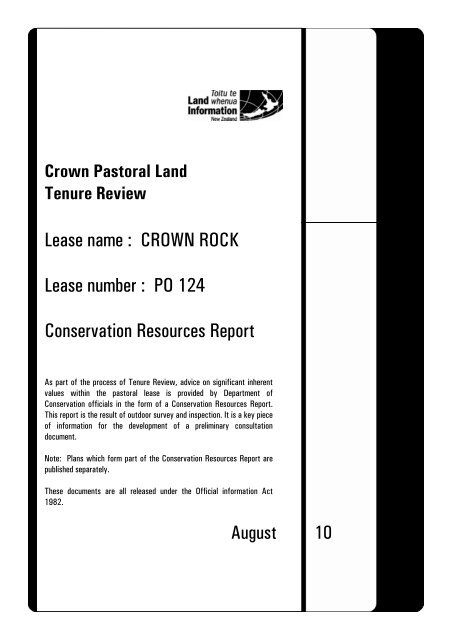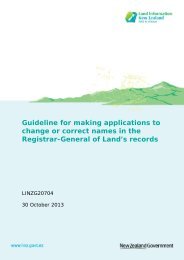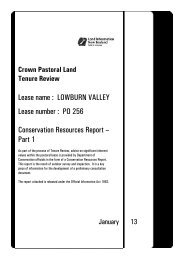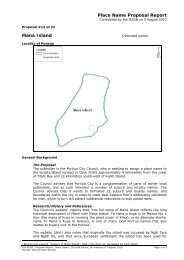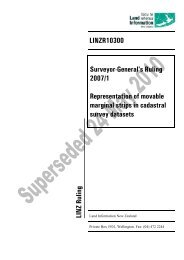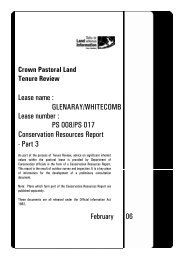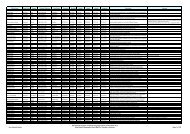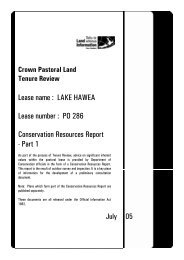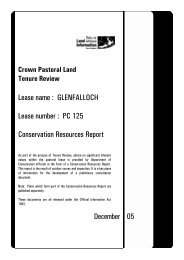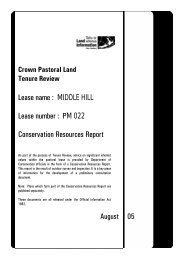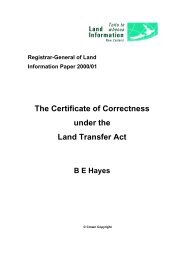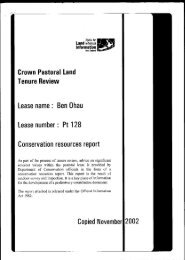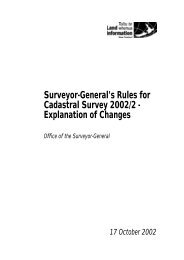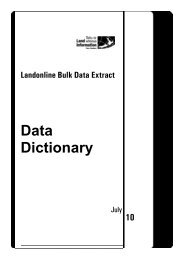Conservation Resources Report - Land Information New Zealand
Conservation Resources Report - Land Information New Zealand
Conservation Resources Report - Land Information New Zealand
You also want an ePaper? Increase the reach of your titles
YUMPU automatically turns print PDFs into web optimized ePapers that Google loves.
Crown Pastoral <strong>Land</strong><br />
Tenure Review<br />
Lease name : CROWN ROCK<br />
Lease number : PO 124<br />
<strong>Conservation</strong> <strong>Resources</strong> <strong>Report</strong><br />
As part of the process of Tenure Review, advice on significant inherent<br />
values within the pastoral lease is provided by Department of<br />
<strong>Conservation</strong> officials in the form of a <strong>Conservation</strong> <strong>Resources</strong> <strong>Report</strong>.<br />
This report is the result of outdoor survey and inspection. It is a key piece<br />
of information for the development of a preliminary consultation<br />
document.<br />
Note: Plans which form part of the <strong>Conservation</strong> <strong>Resources</strong> <strong>Report</strong> are<br />
published separately.<br />
These documents are all released under the Official information Act<br />
1982.<br />
August 10
RELEASED UNDER THE OFFICIAL INFORMATION ACT<br />
2009 ADDENDUM TO<br />
DOC CONSERVATION RESOURCES REPORT ON<br />
TENURE REVIEW OF CROWN ROCK<br />
PASTORAL LEASE<br />
PAL 14-04-124<br />
UNDER PART 2 OF THE CROWN PASTORAL LAND<br />
ACT 1998<br />
DOCDM-447342 Crown Rock CRR Addendum 2009.doc 1
RELEASED UNDER THE OFFICIAL INFORMATION ACT<br />
TABLE OF CONTENTS<br />
PART 1 3<br />
INTRODUCTION ................................................................................................................................................ 3<br />
1.1 Background .............................................................................................................................................. 3<br />
PART 2 4<br />
INHERENT VALUES: DESCRIPTION OF CONSERVATION RESOURCES AND ASSESSMENT OF<br />
SIGNIFICANCE................................................................................................................................................... 4<br />
2.1 <strong>Land</strong> Environments of <strong>New</strong> <strong>Zealand</strong> (LENZ).......................................................................................... 4<br />
2.1.1 Significance of LENZ..................................................................................................................... 5<br />
2.2 Vegetation ................................................................................................................................................ 6<br />
2.2.1 Significance of Vegetation............................................................................................................ 21<br />
2.2.2 Problem Plants.............................................................................................................................. 21<br />
2.3 Invertebrates........................................................................................................................................... 22<br />
2.4 Legal access ........................................................................................................................................... 25<br />
PART 3 26<br />
OTHER RELEVANT MATTERS & PLANS.................................................................................................. 26<br />
3.1 Consultation ........................................................................................................................................... 26<br />
3.2 District Plan............................................................................................................................................ 26<br />
3.3 <strong>New</strong> <strong>Zealand</strong> Biodiversity Strategy........................................................................................................ 26<br />
3.4 Protecting Our Places ............................................................................................................................. 27<br />
3.5 Ecological Sustainability and Carbon Storage ....................................................................................... 27<br />
PART 4 29<br />
ATTACHMENTS............................................................................................................................................... 29<br />
4.1 Additional <strong>Information</strong>........................................................................................................................... 29<br />
4.1.1 References..................................................................................................................................... 29<br />
4.2 Maps....................................................................................................................................................... 30<br />
4.3 Appendices............................................................................................................................................. 30<br />
DOCDM-447342 Crown Rock CRR Addendum 2009.doc 2
RELEASED UNDER THE OFFICIAL INFORMATION ACT<br />
PART 1<br />
INTRODUCTION<br />
1.1 Background<br />
Crown Rock was originally inspected in November 1998. Early tenure review surveys were<br />
generally not as comprehensive as those that are undertaken today and the use of additional tools<br />
(e.g. LENZ and structured SIVs Guidelines) are now available to assist with assessment of<br />
ecological patterns and values present. A re-inspection therefore presented the opportunity to<br />
both examine the original proposed designations and to consider any major deficiencies in the<br />
original proposal.<br />
The re-inspection of the pastoral lease (PL) was undertaken on 16-17 February 2009, for the<br />
purpose of determining if changes were required to the initial <strong>Conservation</strong> <strong>Resources</strong> <strong>Report</strong><br />
(CRR), which was based on information derived from the original inspection carried out on 10-<br />
11 November 1998.<br />
The re-inspection team consisted of Tony Perrett (High Country Tenure Review Manager), Eric<br />
Edwards (Technical Support, Biodiversity Assets - invertebrates), Brian Rance (Technical<br />
Support, Biodiversity Assets - vegetation), Tim Whittaker (High Country Tenure Review<br />
<strong>Conservation</strong> Officer), Brian Murphy (Murihiku Area Office - Programme Manager<br />
Recreation/Historic).<br />
It is important to note that the original assessment and recommendations were done over ten<br />
years ago. However, all the original proposed designations have been reconfirmed as retaining<br />
significant natural heritage and the recommendations made in this report improve and<br />
compliment these. This addendum document is to be read in conjunction with and as an addition<br />
to the original CRR.<br />
The original DOC recommendations relating to the 1998 CRR recommended protection by way<br />
of return to full Crown ownership of the SIVs located in the upper parts of Top Falkans and<br />
Crown Rock blocks. Progress on negotiations failed to materialise in part due to the<br />
impracticality of erecting new boundary fencing, ie contour fencing at this high altitude with its<br />
attendant high risk of repeat snow damage. A different approach is required to progress<br />
negotiations and the new DOC recommendations have been designed to achieve this and also to<br />
take account of new government high country policy whilst meeting the tenure review objectives<br />
for tenure review as contained in the Crown Pastoral <strong>Land</strong> Act.<br />
Additional areas have also been identified as containing significant inherent values, based on the<br />
application of the current version of the SIVs Guidelines. In particular the significance of<br />
riparian beech forest remnants in McPhersons block was noted by DOC.<br />
DOCDM-447342 Crown Rock CRR Addendum 2009.doc 3
RELEASED UNDER THE OFFICIAL INFORMATION ACT<br />
PART 2<br />
INHERENT VALUES: DESCRIPTION OF CONSERVATION<br />
RESOURCES AND ASSESSMENT OF SIGNIFICANCE<br />
The following description and assessment of inherent values is to be read in conjunction with the<br />
original CRR.<br />
2.1 <strong>Land</strong> Environments of <strong>New</strong> <strong>Zealand</strong> (LENZ)<br />
There are two databases that have been used to assess biodiversity protection (Walker et al 2003).<br />
1. Environmental distinctiveness has been assessed through the <strong>Land</strong> Environments of <strong>New</strong><br />
<strong>Zealand</strong> (LENZ). This is a classification of <strong>New</strong> <strong>Zealand</strong> landscapes using a<br />
comprehensive set of climate, landform and soil variables chosen for their roles in driving<br />
geographic variation in biological patterns (Leathwick et al 2002 & 2003). It is presented<br />
at four levels of detail containing 20, 100, 200 or 500 environments nationally. The most<br />
detailed is called LENZ Level IV.<br />
2. The area of unprotected indigenous cover in threatened land environments has been<br />
identified in the national land cover database (LCDB).<br />
From the above databases, spatial data depicting indigenous cover and legal protection were<br />
overlaid on LENZ Level IV environments to identify biodiversity that is most vulnerable (most<br />
likely to be lost). This provides a measure for:<br />
a. percentages legally protected and;<br />
b. percentages of remaining indigenous cover<br />
Based on these two criteria, five categories of threatened environments have been used to identify<br />
environments containing indigenous biodiversity at most risk of loss. They are classified as<br />
follows:<br />
1. Acutely threatened: 30% indigenous cover remaining and 30% indigenous cover remaining and 10-20% protected<br />
6. No Threat: >30% indigenous cover remaining and >20% protected<br />
DOCDM-447342 Crown Rock CRR Addendum 2009.doc 4
RELEASED UNDER THE OFFICIAL INFORMATION ACT<br />
Table 1: <strong>Land</strong> Environments of <strong>New</strong> <strong>Zealand</strong> (LENZ) Units on Crown Rock PL<br />
Threat<br />
Category<br />
Level 4<br />
LENZ<br />
Unit<br />
%<br />
Indigenous<br />
vegetation<br />
cover<br />
remaining<br />
nationally<br />
%Protected<br />
nationally for<br />
conservation<br />
purposes<br />
Indigenous<br />
Vegetation<br />
Cover<br />
Change<br />
Nationally<br />
1997-2002<br />
Approximate Area<br />
on Lease (ha)<br />
At Risk Q4.3a 23 8 Decrease 1036.26<br />
Critically<br />
Underprotect<br />
ed<br />
Q2.1a 38 9 Decrease 93.66<br />
Underprotected Q1.1c 91 18 No change 214.47<br />
Q3.3c 90 17 Decrease 801.17<br />
Q4.1c 52 20 Decrease 0.54<br />
No Threat Q1.1a 98 25 No change 126.76<br />
Category Q1.1d 85 35 No change 1200.35<br />
Q1.2a 99 37 No change 160.36<br />
Q3.1a 67 36 No change 21.32<br />
Q3.3a 97 26 No change 21.05<br />
2.1.1 Significance of LENZ<br />
Attributing significance to LENZ units, while a useful exercise must be treated with caution.<br />
Work is currently underway to improve the accuracy of underlying spatial data. For example,<br />
soils data is being upgraded, as median patch size for polygons sourced from the <strong>Land</strong> Resource<br />
Inventory is currently between 10,000 and 100,000 hectares, while at Level IV resolution, LENZ<br />
units cover areas as small as 10 hectares. Also underway, albeit as lesser priority, is ongoing<br />
work relating to continuous improvements of the underlying classification process which<br />
generates LENZ units.<br />
Crown Rock PL has the following land environments that are significant because the indigenous<br />
vegetation has largely been removed, and/or little of the environment is represented in lands<br />
protected primarily for conservation purposes.<br />
• 28 % of the property has Level IV LENZ Units that have 20-30% of its land area still in<br />
indigenous cover. This includes one ‘At Risk’ Unit Q4.3a.<br />
• 3 % of the property has Level IV LENZ Units that have 30% of their land area still in<br />
indigenous cover and 30% of its land area still in<br />
indigenous cover and >20% protected. These include five ‘No Threat’ Units Q1.1a,<br />
Q1.1d, Q1.2a, Q3.1a and Q3.3a.<br />
DOCDM-447342 Crown Rock CRR Addendum 2009.doc 5
RELEASED UNDER THE OFFICIAL INFORMATION ACT<br />
Where indigenous cover remains within these threatened LENZ units, it attains significance for<br />
tenure review.<br />
LENZ Map and LENZ Units for Crown Rock PL are attached as Appendix 2 . Please note the<br />
areas on the LENZ map are approximate only.<br />
2.2 Vegetation<br />
The field work undertaken during the recent inspection concentrated on the areas of indigenous<br />
vegetation which occur primarily at mid and high altitudes. During the field inspections a sound<br />
overview of the vegetation on the property was obtained. This overview was adequate to<br />
describe the vegetation communities present, the vegetation patterns, the flora and inherent<br />
values of the property.<br />
Ecological Setting<br />
Crown Rock PL lies on the eastern side of the central portion of the Umbrella Mountains. This<br />
area lies centrally within the Umbrella Ecological District (ED). The Umbrella ED is<br />
characterized by having a block-faulted landscape with extensive upland plateaux. Its climate is<br />
of cool temperate, with an annual rainfall from 500-1500, with snow lie for several weeks in the<br />
higher areas (McEwan, 1987).<br />
The original vegetation of the Umbrella ED has been postulated in the Southland Protection<br />
Strategy (Harding, 1999), see table 2. The original vegetation below treeline (c. 1000m) would<br />
have been dominated by beech forest. Above treeline it would have been dominated by a<br />
mixture of sub-alpine shrubland, shrub-tussockland and snow tussockland, with some red<br />
tussockland, flushes and other wetlands, snowbanks, fellfields, rock faces, rock tors and<br />
associated rubblefields. Seven of the eight major ecosystems originally occurring on Crown<br />
Rock PL are still present on the property.<br />
DOCDM-447342 Crown Rock CRR Addendum 2009.doc 6
RELEASED UNDER THE OFFICIAL INFORMATION ACT<br />
Table 2: Ecosystem analysis Umbrella Ecological District<br />
Ecosystem type Original<br />
extent<br />
(% of<br />
ED)<br />
Proportion<br />
of original<br />
extent<br />
remaining<br />
(%)<br />
Proportion<br />
of original<br />
extent<br />
protected<br />
(%)<br />
Montane toutouwai-mixed beech<br />
forest<br />
40 30 19 65<br />
Montane titipounamu-silver beech 35<br />
forest<br />
5 5 40<br />
Montane<br />
colluvium<br />
mixed shrubland on 2 5
RELEASED UNDER THE OFFICIAL INFORMATION ACT<br />
Unit 1: Stronach Hill to Crown Rock<br />
This Unit includes the northern faces of the Umbrella Range. The block extends from Archies<br />
Spur in the south north to the boundary with Whitcoomb PL. The unit includes the upper part of<br />
Gorge Creek. A notable feature of this unit is the abundant slump topography.<br />
This unit is further broken down into three sub-units for the purposes of vegetation description.<br />
These sub-units are the summit ridge, the Umbrella faces and Archies Spur.<br />
Sub-unit: Summit Ridge<br />
This sub-unit represents the highest portion of the property, extending from 1150-1334m. The<br />
vegetation includes fellfields, herbfields, rock outcrops, rocky areas and snow tussockland<br />
communities. The vegetation present at a particular site is largely dependent upon the altitude,<br />
aspect and exposure.<br />
Fellfields:<br />
This community generally occurs on the most exposed sites. The vegetation cover and<br />
composition varies and is largely dependent upon the exposure of the site. The ground cover<br />
contains an abundance of rock and gravel. The vegetation of this community is composed of<br />
much blue tussock (Poa colensoi), the herbs Anisotome flexuosa, Celmisia densiflora and C.<br />
brevifolia, the prostrate shrubs Kelleria villosa, Gaultheria nubicola and Leucopogon fraseri, the<br />
dwarf woodrush Luzula pumila, the moss Rachomitrium lanuginosum, other bryophytes and<br />
lichens. Other plant species recorded include the speargrass - Aciphylla lecomtei, edelweiss<br />
(Leucogenes grandiceps), the willow herb - Epilobium tasmanicum, and the button daisy –<br />
Leptinella pectinata var. willcoxii, the prostrate shrubs snowberry (Gaultheria depressa var.<br />
novae-zelandiae) and Chionohebe densiflora, the clubmoss – Lycopodium fastigiatum and other<br />
species.<br />
Rock outcrops:<br />
These are a prominent feature of the summit ridge. They vary considerably in size and plant<br />
habitat. Characteristic species found include the herbs Anisotome flexuosa, Aciphylla lecomtei,<br />
edelweiss, Celmisia laricifolia, Pachycladon novae-zelandiae and Ourisia caespitosa, the shrubs<br />
Dracophyllum rosmarinifolium, Gaultheria crassa, Leucopogon fraseri and Coprosma<br />
fowerakeri, the grasses Koeleria novo-zelandiae, blue tussock and Rytidosperma setifolia as well<br />
as other species.<br />
Snow tussockland:<br />
This community is more extensive in the other sub-units and is therefore described in more detail<br />
in those sub-units.<br />
Sub-unit: Archies Spur<br />
Archies Spur was identified as a Recommended Area for Protection (RAP) in the Umbrella ED<br />
Protected Natural Areas Programme (PNAP) survey report (Dickinson, 1988). The values<br />
described in that report are still present and the descriptions are still relevant. This sub-unit<br />
extends between the fence on the upper slope above Sandy Creek over Archies Spur north to<br />
include the major gully north of Archies Spur (containing a major stand of beech forest).<br />
DOCDM-447342 Crown Rock CRR Addendum 2009.doc 8
RELEASED UNDER THE OFFICIAL INFORMATION ACT<br />
South faces<br />
The southern (shady) faces of Archies Spur are dominated by snow tussockland, however they<br />
are characterized by extensive rock faces and associated rubblefields, with localized flushes.<br />
Burnt snow tussockland:<br />
There are some recently burnt areas on the lower slope, on shady faces above the 4wd drive<br />
track. This burnt area is relatively localised, however it is regenerating strongly, but will take<br />
some time to recover fully. This community has much pasture grass (browntop, sweet vernal,<br />
Yorkshire fog), with a light cover (c.10% cover) of short stature narrow-leaved snow tussock<br />
(Chionochloa rigida) with much rock and a rich diversity of other native species including<br />
mosses, herbs including the daisy - Celmisia prorepens, the biddibid - Acaena profundeincisa,<br />
Lobelia angulata, the harebell - Wahlenbergia albomarginata, the pennywort - Hydrocotyle<br />
novae zelandiae ssp., ever lasting daisies (Helichrysum filicaule and Anaphalioides bellidioides),<br />
Maori onion (Bulbinella angustifolia), prickly shield fern (Polystichum vestitum), thousand<br />
leaved fern (Hypolepis millefolium), little hard fern (Blechnum penna-marina) and snowberry.<br />
Snow tussockland:<br />
The condition of snow tussockland varies within the sub-unit. At lower altitude and on sunny<br />
aspects the snow tussockland tends to be more modified. However un-burnt narrow-leaved snow<br />
tussockland on shady faces remains in good condition with a strong cover of healthy narrowleaved<br />
snow tussock (c. 50% cover). The area sampled had much of the daisy Celmisia<br />
prorepens (up to 25%, average 15%), pasture grasses (10%) and rock (5%). Also present are the<br />
species found in the burnt area along with the shrubs cottonwood (Ozothamnus vauvilliersii) and<br />
Hebe anomala; herbs gentian - Gentianella bellidifolia, daisy – Dolichoglottis lyallii and<br />
plantain - Plantago lanigera; and clubmoss Lycopodium fastigiatum. On damp sites the herbs<br />
Psychrophila obtusa, Celmisia sp. “gracilenta rhizomatous”, Anisotome aromatica var.<br />
flabellifolia and Ourisia caespitosa; and the sedge Schoenus pauciflorus are all common.<br />
Boulderfields:<br />
This community is a distinctive feature of the shady faces of Archies Spur. The community is<br />
relatively widespread, being derived from the extensive rock faces. The community generally<br />
has a cover dominated by rock (> 50% cover) with much Coprosma dumosa (< 25%). Other<br />
species found include the shrubs Brachyglottis revoluta, porcupine shrub (Melicytus alpinus),<br />
Gaultheria crassa, Myrsine nummularia, Dracophyllum rosmarinifolium, inaka (D. longifolium),<br />
Hebe odora and Pimelea poppelwellii; grasses blue tussock, narrow-leaved snow tussock and<br />
Trisetum lepidum; the speargrass Aciphylla scott-thomsonii and hook grass Uncinia purpurata.<br />
Rock faces:<br />
The extensive and impressive rock faces characterize Archies Spur. These have a rich flora<br />
associated. This flora includes the shrubs Helichrysum intermedium, D. rosmarinifolium, inaka,<br />
Coprosma dumosa, Gaultheria crassa and Parahebe lyallii; the herbs Anisotome haastii, A.<br />
flexuosa, Aciphylla lecomtei, edelweiss, Celmisia prorepens, C. lyallii, C. semicordata,<br />
Dolichoglottis lyallii, Ourisia caespitosa and Colobanthus buchananii; and the filmy fern<br />
Hymenophyllum villosum.<br />
DOCDM-447342 Crown Rock CRR Addendum 2009.doc 9
RELEASED UNDER THE OFFICIAL INFORMATION ACT<br />
North Faces<br />
The northern (sunny) faces of Archies Spur are also dominated by tussockland, with snow<br />
tussockland at higher altitudes and short tussockland at lower altitudes. The northern faces also<br />
contain extensive rock faces, especially at lower and mid altitudes. A feature of the sub-unit is<br />
the diversity of woody communities, including a range of shrublands and beech forest. Minor<br />
communities that add further diversity include rubblefields and flushes/seepages.<br />
Snow tussockland:<br />
This community was not examined in detail. As a consequence of being on the sunny face it has<br />
suffered more from historic burning and stock impacts. Despite this greater level of disturbance<br />
there are extensive areas of good condition narrow-leaved snow tussock at higher altitude.<br />
Generally the snow tussockland extends down to c.900m, below which fescue tussock (Festuca<br />
novae-zelandiae) and pasture grasses become dominant.<br />
One site that was studied was at the head of the basin of the stream on the north side of Archies<br />
Spur. This snow tussockland was dominated by narrow-leaved snow tussock (30-80+%, average<br />
50% cover), with much Celmisia prorepens (10-30%, average 15%), cottonwood (5-10%) and<br />
blue tussock (3-5%). Other components of this snow tussockland include the shrubs Coprosma<br />
cheesemanii, C. perpusilla, Brachyglottis revoluta, Hebe odora and snowberry; the herb<br />
Brachyglottis bellidioides; and Maori onion. In gullies there tends to be more shrubs, along with<br />
the lily - Astelia nervosa, the grass - Poa kirkii and native anemone - Anemone tenuicaulis. On<br />
damp sites Maori onion, Schoenus pauciflorus, Coprosma perpusilla, Psychrophila obtusa and<br />
Anisotome aromatica var. flabellifolia become more common.<br />
Coprosma dumosa – cottonwood shrubland:<br />
This shrubland was located in the upper basin of the stream on the north side of Archies Spur.<br />
The community was not examined in detail however it was observed to be dominated by<br />
Coprosma dumosa and cottonwood. Other prominent components of this shrubland include<br />
Brachyglottis revoluta, Hebe odora, Coprosma cheesemanii and narrow-leaved snow tussock.<br />
Gorge:<br />
This gorge is located along the stream on the north side of Archies Spur. The gorge has provided<br />
a refuge from both fire and stock impacts. Although limited in extent this community is of<br />
botanical interest. The community that occurs on the steep slopes includes the shrubs - inaka, D.<br />
rosmarinifolium, Coprosma dumosa, C. serrulata, C. cheesemanii, Gaultheria crassa, Hebe<br />
odora, Brachyglottis revoluta and mountain ribbonwood (Hoheria glabrata); the herbs Aciphylla<br />
glaucescens, A. scott-thomsonii, A. sp. “lomondii”, A. lecomtei and Dolichoglottis lyallii; the<br />
ferns – mountain kiokio (Blechnum montanum), prickly shield fern, thousand-leaved fern;<br />
mountain flax (Phormium cookianum), narrow-leaved snow tussock and lily – Astelia fragrans.<br />
In addition there are incised side gullies near the top of the beech forest. These have a similar<br />
species composition with the addition of occasional silver beech (Nothofagus menziesii).<br />
DOCDM-447342 Crown Rock CRR Addendum 2009.doc 10
RELEASED UNDER THE OFFICIAL INFORMATION ACT<br />
Forest fringe:<br />
Above the upper slopes of the beech forest are areas of regenerating shrubland. These areas<br />
contain much pasture grass (especially in stock camp areas), prickly shield fern, cottonwood and<br />
thousand-leaved fern. Also present are Hebe odora, inaka, Brachyglottis revoluta, mountain flax<br />
and narrow-leaved snow tussock.<br />
Forest:<br />
There is a tongue of forest along the stream on the north side of Archies Spur. This is one of the<br />
best forest stands on the PL. The forest is dominated by tall (c. 20m high) silver beech. Locally<br />
(especially at lower altitudes) mountain beech (Nothofagus solandri var. cliffortioides) is found.<br />
Understory shrubs are scattered, but include Coprosma dumosa, C. cuneata and Olearia<br />
arborescens. The ground cover includes bryophytes, the ferns hard fern (Blechnum procerum),<br />
Hymenophyllum multifidum, prickly shield fern and Grammitis sp.; the herbs – biddibid (Acaena<br />
anserinifolia), Brachyglottis southlandicus, Lagenifera strangulata, Schizeilema trifoliolatum<br />
and willow herb – Epilobium pedunculare, the sedges Uncinia filiformis, U. clavata and Isolepis<br />
habra; and the lily - Astelia fragrans.<br />
Sunny aspect shrublands:<br />
There is a range of shrubland associations on the sunny faces above the forest.<br />
There is shrubland along several gullies that descend down to the forest. These shrublands<br />
contain Coprosma rugosa, C. tayloriae, koromiko (Hebe salicifolia), mountain ribbonwood,<br />
mountain flax, prickly shield fern, mountain kiokio, Aciphylla glaucescens and minature toetoe<br />
(Chionochloa conspicua).<br />
The lower altitude shrublands that occur on sunny faces are generally dominated by mingimingi<br />
(Coprosma propinqua) and C. rugosa. Other species include C. tayloriae, corokia (Corokia<br />
cotoneaster), porcupine shrub, prickly shield fern and occasional emergent marbleleaf<br />
(Carpodetus serratus) and broadleaf (Griselinia littoralis). This association is sometimes found<br />
on rubblefields.<br />
Rock faces:<br />
The lower rock faces have the shrubs Olearia arborescens, Coprosma rugosa, mingimingi,<br />
broadleaf, marbleleaf, Hebe rakaiensis, Gaultheria crassa and manuka (Leptospermum<br />
scoparium); lawyer vine – Rubus schmidelioides; the herbs Brachyglottis southlandicus and<br />
golden speargrasss (Aciphylla aurea); and hounds tongue fern (Microsorum pustulatum).<br />
Flush/seepage:<br />
There area scattered flush/seepage wetlands on the lower slopes (above the forest). These are<br />
dominated by herbaceous species including Gonocarpus micranthus, Plantago triandra,<br />
Lagenifera petiolata, Lobelia angulata, Hydrocotyle novae-zelandiae, Nertera depressa and<br />
Euchiton ruahinicus; cutty grass (Carex coriacea); and rushes including the native Juncus<br />
edgariae and exotic soft rush (J. effusus).<br />
DOCDM-447342 Crown Rock CRR Addendum 2009.doc 11
RELEASED UNDER THE OFFICIAL INFORMATION ACT<br />
Sub-unit: Umbrella Faces<br />
This sub-unit includes most of the Stronach Hill to Crown Rock unit. It is dominated by snow<br />
tussockland, but contains many flushes, seepages and other wetlands and extends down to<br />
include the forest along Gorge Creek.<br />
Snow tussockland:<br />
This is the most widespread community within the unit. Snow tussocklands are dominated by<br />
narrow-leaved snow tussock that extends from the summit ridge (in places) down to 900m.<br />
However below c. 1000m the narrow-leaved snow tussock is less dense with a corresponding<br />
increase in fescue tussock and pasture grasses. An exception is in the catchment north of<br />
Archies Spur, where good condition tussock land extends down to c. 800m on shady faces where<br />
it is in close proximity to the beech stand.<br />
Slim tussockland:<br />
Slim snow tussockland is restricted to a limited area on the highest slopes below Stronach Hill.<br />
This is the southern most distribution for slim snow tussock (Chionochloa macra) in the<br />
Umbrella ED.<br />
The uppermost altitude snow tussockland is dominated by narrow-leaved snow tussockland (c.<br />
50cm height and c. 25% cover), with much Celmisia prorepens (c. 20%) and blue tussock (c.<br />
8%). Other components of the community include browntop (Agrostis capillaris, c. 5%), the<br />
shrubs – snowberry (4%), Brachyglottis revoluta and cottonwood); leaf litter c. 5%), rock 2-5%),<br />
the clubmoss – Lycopodium fastigiatum (2%), Argyrotegium mackayi (2%), Carex wakatipu and<br />
other species.<br />
The typical snow tussockland is generally similar to that described in the Archies Spur sub-unit.<br />
In gullies (and on damp sites) the shrub component often increases with more cottonwood,<br />
Coprosma cheesemanii, Hebe odora and locally (especially at lower altitude) inaka, Hebe<br />
rakaiensis and mountain ribbonwood. Other species that are more common in gullies include the<br />
ferns prickly shield fern, mountain kiokio, and little hard fern (Blechnum penna-marina); along<br />
with Astelia nervosa and locally mountain flax.<br />
Wetlands:<br />
There is a great diversity of wetlands, including fens on broad gentle ridges, flushes on hill<br />
slopes and others associated with the slumping and gully floors.<br />
The largest wetland system that was surveyed was located on a broad, gentle ridge (Grid Ref<br />
NZMS260 F44 026 990, c. 1050m). This wetland contains a mosaic of different associations.<br />
The major and most distinctive of these associations are described below.<br />
Schoenus pauciflorus flush:<br />
This association is dominated by the sedge Schoenus pauciflorus with bryophytes, the herbs –<br />
the pennywort Hydrocotyle novae-zelandiae var. montana, the buttercup Ranunculus gracilipes,<br />
Lobelia angulata, native gentian Gentianella bellidifolia and daisy Celmisia sp. “rhizomatous<br />
gracilenta”, and the grass Rytidosperma australe.<br />
DOCDM-447342 Crown Rock CRR Addendum 2009.doc 12
RELEASED UNDER THE OFFICIAL INFORMATION ACT<br />
Carex gaudichaudiana flush:<br />
This association is dominated by the sedge Carex gaudichaudiana with much exotic sweet<br />
vernal grass (Anthoxanthum odoratum). Other species include Maori onion, the sedge Carpha<br />
alpina along with the herbs Gentianella bellidifolia, Celmisia sp. “rhizomatous gracilenta”,<br />
Hydrocotyle novae-zelandiae var. montana, Ranunculus gracilipes, Lobelia angulata and native<br />
violet – Viola cunninghamii.<br />
Sphagnum bog:<br />
This association is dominated by the sphagnum moss (Sphagnum cristatum). Associated are the<br />
sedges Carex gaudichaudiana, Schoenus pauciflorus and Carpha alpina, along with the herbs<br />
Celmisia sp. “rhizomatous gracilenta”, Ranunculus gracilipes, Euchiton lateralis, the sundew<br />
Drosera arcturi and Viola cunninghamii, the prostrate shrub Coprosma perpusilla and<br />
occasional hybrid red tussock (Chionochloa rubra var. cuprea x C. rigida). Locally common<br />
within this community is the shrub Hebe pauciramosa and daisy Celmisia glandulosa.<br />
Cushion bog:<br />
This community was localized though highly distinctive. The cushion bog was dominated by the<br />
comb sedge Oreobolus pectinatus (c. 75% cover), with sphagnum moss (8%), Carex<br />
gaudichaudiana (5%), Carpha alpina (3%), Drosera arcturi (2%), Celmisia sp. “rhizomatous<br />
gracilenta” (1%), sweet vernal (1%), Abrotanella caespitosa, Hydrocotyle novae-zelandiae var.<br />
montana and Ranunculus gracilipes.<br />
Other wetland communities recorded include:<br />
Alpine bog:<br />
This community was recorded from Grid Ref. NZMS 260 F44 018 990 on a peaty substrate. The<br />
bog was dominated by the comb sedge Oreobolus pectinatus (c. 25% cover), with much narrowleaved<br />
snow tussock (c. 15%), Celmisia sp. “rhizomatous gracilenta” (12%), Ranunculus<br />
gracilipes (10%), sphagnum moss (10%) and other bryophytes (6%). Other minor components<br />
include Dracophyllum prostratum (4%), Carex gaudichaudiana (3%), Abrotanella caespitosa<br />
(3%), Coprosma perpusilla (2%), Phyllachne colensoi (2%), Drosera arcturi (1%), Carex<br />
sinclairii (1%), Centrolepis pallida (1%), Carpha alpina and Gentianella amabilis.<br />
Hill slope flushes/wetlands:<br />
These are sometimes associated with the slump topography and in other places on hill slopes.<br />
The flushes are variable dependent upon hydrology, substrate, fertility, slope and other physical<br />
features. The flushes are naturally fertile and tend to attract stock. Flushes at lower altitudes<br />
have greater stock damage and have a greater proportion of exotic species associated.<br />
There are many areas of flush/wetland. These vary in size and composition. They are generally<br />
dominated by bryophytes (60-80%, average 75%), with much Schoenus pauciflorus (5-20%,<br />
average 10%). Also common are several herb species including Ranunculus gracilipes (1-10%),<br />
Celmisia sp. “rhizomatous gracilenta” (1-5%), Plantago unibracteata (1-5%), Viola<br />
cunninghamii (+-2%), Rununculus cheesemanii (+-2%), Hydrocotyle novae-zelandiae var.<br />
DOCDM-447342 Crown Rock CRR Addendum 2009.doc 13
RELEASED UNDER THE OFFICIAL INFORMATION ACT<br />
montana and Lobelia angulata. Other species include Carex gaudichaudiana, C. hectorii and<br />
Hebe pauciramosa.<br />
Streamside wetland:<br />
This wetland community was recorded from relatively flat areas adjacent to a stream (sampled at<br />
Grid Ref. NZMS 260 F44 019 990. This community was dominated by bryophytes (c. 85%<br />
cover), with cutty grass (5%), Psychrophila obtusa (3%), Schoenus pauciflorus (2%), Plantago<br />
unibracteata (2%), Ranunculus gracilipes (1%), Hydrocotyle novae-zelandiae var. montana<br />
(1%) and other species.<br />
Dracophyllum rosmarinifolium shrubland:<br />
This shrubland community was scattered across upper slopes of the block though mainly on<br />
southerly aspects. They are often associated with the crest of slump areas and boulderfields and<br />
rock outcrops. An example associated with a slump crest was dominated by narrow-leaved snow<br />
tussock (25% cover), Celmisia prorepens (18%), D. rosmarinifolium (15%), blue tussock (8%),<br />
Brachyglottis revoluta (6%) and leaf litter (5%). Associated components of the community<br />
include rock (4%), Gaultheria crassa (3%), snowberry (2%), Lycopodium fastigiatum (2%),<br />
sweet vernal (2%), Hebe odora (1%), Dolichoglottis lyallii (1%), Ourisia caespitosa (1%) and<br />
other species.<br />
A second example sampled was on a boulderfield. This community was dominated by D.<br />
rosmarinifolium (25% cover), rock (25%), Brachyglottis revoluta (18%), narrow-leaved snow<br />
tussock (8%) and blue tussock (6%). Other associated species include Celmisia brevifolia (4%),<br />
lichen (3%), Celmisia laricifolia (2%), snowberry (2%), bryophytes (2%), little hard fern (1%),<br />
prickly shield fern, Aciphylla scott-thomsonii, A. lecomtei, Dracophyllum prostratum and other<br />
species.<br />
Unit 2: Falkans Faces<br />
This unit includes the southern faces of the Umbrella Range from the Falkan Faces south to Trig<br />
D and the boundary with Hukarere PL. The unit includes the upper catchment of Sandy Creek<br />
and Archies Creek. The vegetation within this unit is dominated by snow tussockland extending<br />
from the summit down to mid altitudes with modified tussock land below grading into pasture.<br />
Also present are localized areas of fellfield, wetland and shrubland.<br />
Fellfields:<br />
The fellfields are similar to those previously described in the Stronach Hill to Crown Rock unit.<br />
However within the Falkan Faces unit they are less extensive due to the lower altitude of the<br />
summit.<br />
Snow tussocklands:<br />
This is the most extensive indigenous vegetation remaining in this unit. Relatively intact snow<br />
tussocklands extends down to c. 900m. The most intact snow tussocklands are at upper altitudes<br />
and on shady aspects. An area of snow tussockland was sampled at Grid Ref. NZMS 260 F44<br />
016 983. This snow tussockland was dominated by narrow-leaved snow tussock (35-75%,<br />
average 55% cover), with much blue tussock (2-10%, average 6%), Coprosma cheesemanii (3-<br />
6%, average 5%), bryophytes (c.5%), snowberry (2-6%, 4%) and leaf litter. Other minor<br />
DOCDM-447342 Crown Rock CRR Addendum 2009.doc 14
RELEASED UNDER THE OFFICIAL INFORMATION ACT<br />
components include cottonwood (3%), Schoenus pauciflorus (3%), Lycopodium fastigiatum<br />
(2%), Forstera sedifolia (2%), Celmisia prorepens (2%), Ranunculus ensyii (1%), Anisotome<br />
aromatica var. flabellifolia (1%), Coprosma perpusilla, Anemone tenuicaulis and other species.<br />
Wetlands:<br />
There are scattered flushes/seepages on the hill slopes, however they are less common than in the<br />
Stronach Hill to Crown Rock unit. They are generally similar to those found in the Stronach Hill<br />
to Crown Rock unit.<br />
Shrublands:<br />
There are limited areas of shrubland within this unit. A gully south of Sandy Creek on a north<br />
aspect, above a farm track (Grid Ref NZMS 260 F44 013 965, c. 750m) was surveyed. This<br />
tributary of Sandy Creek has a remnant of forest-shrubland associated with rocky gorge areas<br />
that form fire refuges. The community contains a range of plants including the woody species<br />
mountain ribbonwood and koromiko, mountain kiokio and prickly shield fern along with silver<br />
beech, broadleaf, tree fuchsia (Fuchsia excorticata), Coprosma rugosa, C. tayloriae, minimingi,<br />
inaka, Olearia arborescens, false beech (Gaultheria antipoda); the vines - lawyer vine Rubus<br />
cissoides and pohuehue (Muehlenbeckia australis); the ferns mountain kiokio and prickly shield<br />
fern (both common), hounds tongue fern and bracken (Pteridium esculentum); mountain flax,<br />
miniature toeotoe, glaucous speargrass (all common), narrow-leaved snow tussock and Astelia<br />
nervosa. This site is notable for the presence of the threatened willow herb, Epilobium pictum<br />
(status – Nationally endangered).<br />
Below the track the shrubland is more confined to the stream margins and is less diverse. Here<br />
the shrubland is dominated by mingimingi, with some Coprosma rugosa and occasional<br />
koromiko, mountain ribbonwood, broadleaf, mountain flax and other species.<br />
Associated with Sandy Creek are scattered pockets of silver beech, with much prickly shield fern<br />
above on the north side. However the adjacent sunny faces are more modified, consisting of<br />
mainly of pasture species with some short tussock and scattered shrubs.<br />
Unit 3: Stronach Range<br />
This unit is the catchment of Camping Creek and includes the upper portion of Sandy Spur and<br />
Stronach Range. This unit contains a cap of snow tussock with areas of wetland and associated<br />
red tussock on the broad, gentle, upper Sandy Spur. A feature of the vegetation is the remnant<br />
stands of beech forest along Camping Creek and its tributaries. A feature of the topography is the<br />
extensive slump topography.<br />
Snow tussockland:<br />
As is typical, the condition of the snow tussockland increases with altitude. An area sampled<br />
was at a relatively low altitude (c. 950m), with a level of modification by stock and exotic<br />
species. At this site the snow tussockland was dominated by browntop (c. 45% cover), narrowleaved<br />
snow tussock (c. 25%), blue tussock (8%), Celmisia densiflora (6%), Gaultheria<br />
macrostigma (5%) and snowberry (4%). Other minor associated species include ever-lasing<br />
daisy (Anaphalioides bellidioides, 2%), bryophytes (1%), Lycopodium fasigiatum (1%), catsear<br />
DOCDM-447342 Crown Rock CRR Addendum 2009.doc 15
RELEASED UNDER THE OFFICIAL INFORMATION ACT<br />
(Hyochaeris radicata, 1%), Plantago lanigera (1%), Dolichoglottis lyallii, Maori onion, and<br />
Schoenus pauciflorus.<br />
Wetlands:<br />
There was a range of wetlands present. Again these occur on a range of landform including<br />
broad, gentle ridges, hill slopes and associated with slumps. One of the largest wetland systems<br />
was located on the broad, gentle, upper Sandy Spur (Grid Ref NZMS 260 F43 050 003, c.<br />
970m).<br />
Cushion bog:<br />
Cushion bogs are localised but highly distinctive wetland systems. A couple of different cushion<br />
bogs were sampled. The first cushion bog was dominated by the comb sedge Oreobolus<br />
pectinatus (c. 65% cover), with much red tussock (20%) and sphagnum moss (5%). Other<br />
associated species include Coprosma perpusilla (1-5%, average 2%), Carex gaudichaudiana<br />
(1%), Carpha alpina (1%), Abrotanella caespitosa (1%), Drosera arcturi, Celmisia sp.<br />
“rhizomatous gracilenta” and other species.<br />
A second cushion bog consisted of comb sedge Oreobolus pectinatus (c. 72% cover), with much<br />
Carpha alpina (12%) and bryophytes (10%). Other associated species include Schoenus<br />
pauciflorus (4%), Celmisia sp. “rhizomatous gracilenta”, C. glandulosa, Drosera arcturi,<br />
Gentianella amabilis and other species.<br />
Sphagnum – herb bog:<br />
This wetland is dominated by sphagnum moss (65% cover), with much Ranunculus gracilipes<br />
(8%) and Carpha alpina (8%). Other associated species include Celmisia sp. “rhizomatous<br />
gracilenta” (4%), Abrotanella caespitosa (3%), Viola cunninghamii (3%), Hydrocotyle novaezelandiae<br />
var. montana (2%), liverwort (1%), Oreobolus pectinatus, Plantago unibracteata,<br />
Carex gaudichaudiana, Psychrophila obtuse and other species.<br />
Red tussockland:<br />
This red tussockland is a fen community found around the cushion bog (first example described<br />
above). The tussockland is dominated by red tussock (25-50%, average 35%), with much<br />
sphagnum moss (c. 15-20%), Coprosma perpusilla (8%), Oreobolus pectinatus (5%) and<br />
Abrotanella caespitosa (5%). Other associated species include Carex gaudichaudiana (3%),<br />
Carpha alpina (2%), Celmisia sp. “rhizomatous gracilenta” (2%), other bryophytes (2%),<br />
Gaultheria macrostigma (1%), Maori onion (1%), Oreobolus strictus, Drosera arcturi,<br />
Lycopodium fasigiatum, Phyllachne colensoi, Gonocarpus aggregatus, Ranunculus gracilipes,<br />
little hard fern and other species.<br />
A second example was sampled on the upper section of Sandy Spur (Grid Ref NZMS 260 F43<br />
050 001). This tussockland was dominated by bryophytes (30% cover), sphagnum moss (20%),<br />
red tussock (15%), Coprosma perpusilla (8%), Celmisia sp. “rhizomatous gracilenta” (6%) and<br />
Carpha alpina (5%). Other components of this tussockland include Ranunculus gracilipes (4%),<br />
Abrotanella caespitosa (3%), Carex gaudichaudiana (2%), Gaultheria macrostigma (2%),<br />
Celmisia glandulosa (1%), Phyllachne colensoi, Oreobolus pectinatus, Drosera arcturi,<br />
Gentianella amabilis and other species.<br />
DOCDM-447342 Crown Rock CRR Addendum 2009.doc 16
RELEASED UNDER THE OFFICIAL INFORMATION ACT<br />
Flushes/wetlands:<br />
As in the Stronach Hill to Crown Rock unit, these are common and variable dependent upon<br />
local site influences. Hill slope flushes are generally dominated by bryophytes. A number of<br />
sites were sampled.<br />
One example that was at lower altitude with some stock damage was composed of mainly<br />
bryophytes (70% cover), with Ranunculus gracilipes (8%), Celmisia sp. “rhizomatous<br />
gracilenta” (6%), Maori onion (3%), sweet vernal (3%), Oreobolus pectinatus (2%), Euchiton<br />
lateralis (2%), Carpha alpina (1%), Schoenus pauciflorus (1%), cutty grass (1%), and several<br />
other species.<br />
A second example consisted of bryophytes (75% cover), with Carex sinclairii (15%),<br />
Hydrocotyle novae-zelandiae var. montana (3%), bog stichwort (Stellaria alsine, 3%), Plantago<br />
unibracteata (1%), Maori onion, liverwort and other species.<br />
A third example was in a slump depression. This wetland was also dominated by bryophytes,<br />
with some sedges - Carex gaudichaudiana, Schoenus pauciflorus and Isolepis aucklandicus; the<br />
grass – Rytidosperma australe and sweet vernal; and a rich diversity of herbs including Euchiton<br />
lateralis, Viola cunninghamii, Lobelia angulata, Plantago unibracteata, Hydrocotyle novaezelandiae<br />
var. montana, Epilobium komarovianum, Celmisia sp. “rhizomatous gracilenta”,<br />
Ranunculus foliosus, R. gracilipes, Gentianella bellidifolia, and Craspedia spp. Also found but<br />
with a local distribution were Celmisia glandulosa and Abrotanella caespitosa.<br />
Sphagnum bog:<br />
This was located on a flat area above the forest. The bog was dominated by sphagnum moss (c.<br />
75% cover), with much cutty grass (20%). Other associated species include Carex<br />
gaudichaudiana (2%), spike rush (Eleocharis acuta, 1%), sweet vernal (1%), soft rush (Juncus<br />
effusus), jointed rush (J. articulatus), Hydrocotyle novae-zelandiae var. montana, Maori onion<br />
and odd-leaved orchid (Aporostylis bifolia).<br />
Beech forest:<br />
The beech forest is dominated by silver beech. The understory is sparse, containing scattered<br />
Coprosma dumosa, weeping mapou (Myrsine divaricata), occasional Coprosma rhamnoides, C.<br />
pseudocuneata, three finger (Pseudopanax colensoi var. ternatus) and Hall’s totara (Podocarpus<br />
hallii). The ground cover includes the ferns - prickly shield fern, water fern (Histiopteris<br />
incisa)(both locally dense), little hard fern and filmy fern Hymenophyllum multifidum; the herbs<br />
Viola filicaulis, Lagenifera strangulata, Epilobium pedunculare, Nertera villosa, groundsel<br />
Senecio wairauensis and nettle Urtica incisa; hook grass Uncinia clavata and spider orchid<br />
Nematocerus trilobum.<br />
Rock outcrops and associated boulderfields:<br />
There is an extensive rock out crop system with associated boulderfields located on the east side<br />
of the lower portion of Camping Creek Valley. The vegetation is similar to that found on the<br />
north side of Archies Spur, however it has been more disturbed.<br />
DOCDM-447342 Crown Rock CRR Addendum 2009.doc 17
RELEASED UNDER THE OFFICIAL INFORMATION ACT<br />
Unit 4: Pomahaka Faces<br />
This unit is the remainder of the PL not included in units 1-3. This is the most developed part of<br />
the PL, with most having been cultivated or top-dressed and oversown. There are limited<br />
remnants of indigenous vegetation within this block. These remnants are generally associated<br />
with water watercourses, rocky areas or steep slopes. The block includes the Pomahaka faces,<br />
east side of Stronach Range and lower port of the Sandy Creek catchment.<br />
Beech forest:<br />
There are a few small remnants of silver-mountain beech. These are associated with streams.<br />
These remnants are narrow and not fenced from stock, therefore they are stock impacted with<br />
limited understory or regeneration.<br />
Incised streams:<br />
These are a feature of Sandy Creek and lower Gorge Creek. Remnants of indigenous vegetation<br />
are associated with the steeps banks and associated rock faces, where stock or fires have not<br />
reached. These have a diverse flora which includes the woody species - broadleaf, mountain<br />
ribbonwood, inaka, koromiko, Hebe rakaiensis, mingimingi, Coprosma rugosa, C. rigida,<br />
corokia, mountain wineberry (Arisotelia fruticosa), native broom Carmichaelia virgata,<br />
matagouri (Discaria toumatou) and porcupine shrub; glaucous speargrass, Gingidia montana,<br />
mountain flax, minature toetoe and narrow-leaved snow tussock.<br />
Mixed shrublands:<br />
This shrubland is likely to once have been widespread at lower altitude on the PL, however as a<br />
consquence of burning and associated land development it has become uncommon. The best<br />
area examined is located at Grid Ref. NZMS260 F44 059 956. This area is only c. 3ha. The<br />
shrubland contains Olearia fimbriata, O. lineata, mingimingi, C. rugosa, porcupine shrub,<br />
Muehlenbeckia complexa, Rubus schmidelioides, bracken and other species. Under the most<br />
dense canopy areas ground cover species found included Poa matthewsii, Acaena juvenca,<br />
Chaerophyllum ramosum, Epilobium nummulariifolium and others. The presence of Olearia<br />
fimbriata (status – Nationally vulnerable) and O. lineata (status – Declining) is notable.<br />
Flora<br />
A flora of 276 native species has been recorded from the PL (see attached list). This flora is<br />
considered relatively diverse and is much richer considering the highly developed nature of<br />
much of the PL. The flora includes 24 fern species, 65 trees and shrubs, 5 climbers and vines,<br />
110 herbaceous species, 30 grasses, 23 sedges, 5 orchids, 9 rushes and 5 other monocot species.<br />
This flora is considered highly representative of both the Umbrella Mountains and the wider<br />
Umbrella ED.<br />
The flora includes 9 nationally threatened and uncommon plants (de Lange et al., 2009)<br />
Aciphylla lecomtei (status – Naturally uncommon)<br />
Anemone tenuicaulis (status - Naturally uncommon)<br />
Carex lachenalii ssp. Parkeri (status - Naturally uncommon)<br />
Epilobium pictum (status – Nationally endangered)<br />
DOCDM-447342 Crown Rock CRR Addendum 2009.doc 18
RELEASED UNDER THE OFFICIAL INFORMATION ACT<br />
Juncus pusillus (status - Naturally uncommon)<br />
Olearia fimbriata (status – Nationally vulnerable)<br />
Olearia lineata (status – Declining)<br />
Pimelea poppelwellii (status - Naturally uncommon)<br />
Uncinia purpurata (status - Naturally uncommon)<br />
Of greatest significance is the presence of Epilobium pictum which has the highest threat status<br />
and has been recorded from very few sites within Southland or Otago.<br />
In addition, there are several species recorded that are uncommon within the Umbrella ED.<br />
These species include: trees and shrubs - Brachyglottis buchananii, B. revoluta, Coprosm<br />
fowerakeri, C. serrulata, Hebe propinqua, H. rakaiensis, Hoheria lyallii, Olearia bullata,<br />
Podocarpus hallii, Pseudopanax colensoi var. ternatus, Sophora microphylla; Herabceous<br />
species - Aciphylla scott-thomsonii, Anisotome haastii, Epilobium glabellum, Gingidia montana<br />
and Microseris scapigera; Grass – Poa kirkii.<br />
Notable ecological features of Crown Rock PL<br />
• Umbrella summit ridge – This contains rock tors and associated boulderfield that provide<br />
habitat for a rich diversity of plants. These features also have provided a fire refuge and<br />
so retain some species that have become uncommon. The summit ridge also contains<br />
areas of fellfield vegetation in the most exposed sites.<br />
• Extensive snow tussockland – There is a cap of narrow-leaved snow tussockland on the<br />
upper slopes of the Umbrella Mountains. This snow tussock cap extends above the 900m<br />
contour, up to or near the summit ridge. Despite the long history of pastoral use, the<br />
snow tussockland remains in good condition and retains a rich diversity of native plant<br />
species. These snow tussocklands are highly representative of the original alpine<br />
vegetation of the Umbrella ED. Particularly good examples are on the Falkan Faces.<br />
• Wetlands – There is an abundance and diversity of wetlands present and they form a<br />
characteristic feature of the PL. The wetlands vary according to topographical features,<br />
hydrological functioning (including water source, drainage etc), soils, fertility and other<br />
factors. Some wetlands are relatively large,eg.,the fen wetlands on broad upland ridges.<br />
Others are flushes/seepages on hill slopes or associated with depressions and hollows<br />
within slump topography.<br />
• Upland red tussockland – Upland red tussockland is associated with broad poorly drained<br />
ridges. The patterning of red tussockland and snow tussockland is largely a consequence<br />
of differences in soils, moisture, drainage, topography and other physical factors. Upland<br />
red tussockland is localized within the Umbrella ED and differs from the fire induced red<br />
tussockland of low and mid altitudes. With increased land development, red tussockland<br />
is becoming increasing rare within the Umbrella ED. The most extensive area is the<br />
upper portion of Sandy Spur.<br />
DOCDM-447342 Crown Rock CRR Addendum 2009.doc 19
RELEASED UNDER THE OFFICIAL INFORMATION ACT<br />
• Slump topography – The mid and upper slopes have abundant slump features These are<br />
of varying sizes and types. They make for a distinctive and characteristic landscape but<br />
also provide small scale topographic diversity which is reflected in the vegetation. In<br />
particular they have resulted in the formation of some wetlands.<br />
• Rock outcrops and associated boulderfields – These differ subtly from those along the<br />
summit ridge. These are found at lower altitude and are less exposed. They have a<br />
distinctive flora and serve as a refuge site for several species. Though they are relatively<br />
widespread the most extensive are associated with Archies Spur (on both north and south<br />
aspects). The rock outcrop systems are probably the best on the Umbrella Mountains,<br />
which is why they were identified as an RAP in the Umbrella ED PNAP survey.<br />
• Forest – There are several stands of forest, however they are largely confined to Gorge<br />
and Camping Creek catchments. They are generally narrow often being confined to steep<br />
gorgy areas along the streams. As a consequence of the narrow width they are generally<br />
stock impacted. The importance of these stands far belies their small size and fragmented<br />
nature. They are highly representative of the original beech forest that once dominated<br />
the vegetation cover of the Umbrella ED.<br />
• Gorgy river channels – These are a feature of the streams (especially Gorge Creek above<br />
the confluence with Sandy Creek). They extend down to low altitudes. As a<br />
consequence of the incised nature of the stream there are numerous small bluffs and steep<br />
rocky banks that have provided a refuge from both fires and stock. They retain a rich<br />
diversity of riparian vegetation.<br />
• Low altitude shrublands – There are very limited areas of shrubland remaining on the PL<br />
(as a consequence of intensive development). These remnants do contain two species of<br />
threatened tree daisies – Olearia fimbriata and O. lineata.<br />
• Strategic significance - The snow tussocklands and summit ridge communities have an<br />
important role in providing vegetation and landscape continuity along the Umbrella<br />
Range. This vegetation serves to link the extensive snow tussocklands and beech forest<br />
in the south (on Hukarere PL and the Leithen Bush Scenic Reserve) with extensive snow<br />
tussocklands, wetlands and beech forest in the north (Whitecoomb PL, Argyle PL, Gem<br />
Lake PL and Waikaia Bush <strong>Conservation</strong> Area). This extensive area along the Umbrella<br />
Mountains could form an integral part of any future <strong>Conservation</strong> Park.<br />
See Appendix 1 for a full list of plant species.<br />
DOCDM-447342 Crown Rock CRR Addendum 2009.doc 20
RELEASED UNDER THE OFFICIAL INFORMATION ACT<br />
2.2.1 Significance of Vegetation<br />
Crown Rock is a relatively highly developed PL, and areas of improved pasture dominate the<br />
vegetation. The improved pasture is maintained partly by a major top-dressing and over-sowing<br />
programme. Much of the remaining indigenous vegetation is confined to the higher parts of the<br />
PL. Elsewhere the indigenous vegetation consists of small remnants that are generally associated<br />
with stream banks, rocky areas or steep slopes. Between the initial Tenure Review survey in<br />
1998 and the recent survey in February 2009, there has been little change in vegetation<br />
condition, with possibly some recovery in some areas.<br />
There is a cap of relatively intact high altitude snow tussockland with associated wetlands and<br />
summit ridge vegetation along the Umbrella Mountains. This is the most extensive indigenous<br />
vegetation on the PL. This vegetation has high strategic importance linking with expansive areas<br />
of forest, tussockland and associated vegetation to the south (on Hukarere PL and the Leithen<br />
Bush Scenic Reserve) and north (Whitecoomb PL, Argyle PL, Gem Lake PL and also linking<br />
with Waikaia Bush <strong>Conservation</strong> Area and Glenaray PL). However below this solid cap of good<br />
condition indigenous vegetation the vegetation becomes more modified and the values more<br />
fragmented. The forest stand in the Gorge Burn and Camping Creek represents the original<br />
vegetation that once dominated the mid and lower altitudes of the PL. Despite a level of<br />
modification on the mid slopes, these slopes still maintain a range of important values including<br />
rock outcrops, rubblefields, shrublands and wetlands. The widespread occurrence of shrub<br />
species and prickly shield fern indicate the ready ability of these areas to recover and regenerate.<br />
It is vitally important to maintain the linkages from the summit ridge down to the forested<br />
gullies.<br />
Cattle appear to be the major stock on the PL. There is evidence of cattle throughout the PL,<br />
even onto the summit ridge of the Umbrella Mountains. There are stock camps associated with<br />
sunny faces and around some rock outcrops. Wetlands at low and mid altitudes have been<br />
heavily impacted by stock. The flushes are nutrient rich and so tend to attract stock especially<br />
cattle to them, resulting in degradation through pugging and spread of exotic plants. Many<br />
wetlands are relatively small so more vulnerable to modification. The maintenance and<br />
enhancement of wetlands is largely incompatible with the increasingly intensive farming<br />
practices (including heavy stocking rates and fertilizer inputs) undertaken on this PL.<br />
Likewise the diversity of woody vegetation is a special feature of the PL. This has been severely<br />
restricted by pastoral practices especially fire and grazing. If these activities continue these<br />
special vegetation features will continue to be suppressed. The recovery of this vegetation is<br />
largely incompatible with the increasingly intensive farming practices undertaken on this<br />
property.<br />
2.2.2 Problem Plants<br />
Nil<br />
DOCDM-447342 Crown Rock CRR Addendum 2009.doc 21
RELEASED UNDER THE OFFICIAL INFORMATION ACT<br />
2.3 Invertebrates<br />
The inspection occurred in variable overcast and fine weather with mild breezes. Insects were<br />
noted or hand collected for later identification and most parts of the station were inspected from<br />
access tracks or in some parts by walking.<br />
The table 3 below shows shrubland and upland insects including 16 insect species and a<br />
threatened giant land snail. The habitats for the insects are shown in the table’s comments and<br />
include tussockland, shrubland, rock face, wetland/cushion bog, rock fell and herb field.<br />
Table 3: Invertebrates noted during re-inspection 19 Feburary 2009<br />
Family & Species Locality& Elevation Comment<br />
Lepidoptera -moths<br />
and butterflies<br />
Crambidae<br />
Diasemia marmarina trib.<br />
Gorge<br />
Creek 900 m<br />
Orocrambus n.sp. Sandy<br />
cushion (B. H. Patrick)<br />
Geometridae<br />
Spur 1100 m<br />
Aponotoreas insignis Archies 1080-1140<br />
Spur m<br />
Archies 1080-1140<br />
Asaphodes clarata<br />
Spur<br />
Asaphodes clarata trib.<br />
Gorge<br />
Creek<br />
Asaphodes nephelias Archies<br />
Spur<br />
Moth. Larvae eat Urtica nettles<br />
Moth. Known from Otago mountains.<br />
Inhabits cushion bog.<br />
m Moth. Larvae eat Ranunculus buttercup<br />
900 m<br />
1080-1140<br />
m Moth. Females are flightless<br />
Asaphodes nephelias Sandy<br />
Spur 1100 m<br />
Asaphodes prasinias trib.<br />
Gorge<br />
Creek 900 m Moth. Inhabits open shrubland/forest sites<br />
Notoreas perornata Archies<br />
Spur 1120 m Moth. Larvae eat Pimelea native daphne<br />
Lycaenidae<br />
Lycaena species trib.<br />
Gorge<br />
Creek 800 m<br />
Nymphalidae<br />
Bassaris gonerilla trib.<br />
Gorge 600 m<br />
Common copper butterfly. Larvae feed on<br />
Muehlenbeckia australis<br />
Red admiral butterfly. Larvae eat Urtica<br />
nettles<br />
DOCDM-447342 Crown Rock CRR Addendum 2009.doc 22
RELEASED UNDER THE OFFICIAL INFORMATION ACT<br />
Creek<br />
Oecophoridae<br />
Hieroderis polita trib.<br />
Gorge<br />
Creek 900 m Moth. Larvae eat rockface moss or lichen<br />
Peridae<br />
Peris rapae<br />
Satyridae<br />
Archies<br />
Spur<br />
trib.<br />
1120 m<br />
Argyrophenga<br />
Gorge<br />
antipodum<br />
Creek 900 m A tussock ringlet butterfly<br />
Argyrophenga<br />
Archies 1050-1140<br />
antipodum<br />
Spur m<br />
Argyrophenga<br />
Sandy<br />
antipodum<br />
Spur 1100 m<br />
Archies 1080-1140<br />
Argyrophenga janitae Spur<br />
trib.<br />
m A tussock ringlet butterfly<br />
Gorge 800 -1100<br />
Creek m Moth<br />
Gelophaula sp.<br />
Hemiptera -cicada<br />
Tibicinidae<br />
Kikihia angusta<br />
Orthoptera -weta<br />
Stenopelmatidae<br />
Hemideina maori<br />
Mollusca -landsnail<br />
Rhytidae<br />
Powelliphanta spedeni<br />
var. spedeni<br />
trib.<br />
Gorge<br />
Creek 600 m A grassland cicada<br />
Crown<br />
Rock 1200 m<br />
Archies<br />
Spur 1050 m<br />
trib.<br />
Gorge<br />
Creek 1040 m<br />
Mountain stone weta. Associated with<br />
rock fell at tors on the Station. Black<br />
Umbrella Range is the southern limit of<br />
distribution for this large weta known from<br />
Canterbury and Otago localities<br />
Spedens giant landsnail. Found only in<br />
northern Southland Mountains and only<br />
protected in a few Eyre Mountain sites, it<br />
has a threat classification of serious<br />
decline.<br />
DOCDM-447342 Crown Rock CRR Addendum 2009.doc 23
RELEASED UNDER THE OFFICIAL INFORMATION ACT<br />
Rare and threatened invertebrate species<br />
Two at risk invertebrates and one data deficient species were noted in table 4 below. However,<br />
the Umbrella Mountains and habitats represented on the PL are likely to carry many more<br />
naturally uncommon and rare species known elsewhere in the region and in shrublands of<br />
Central Otago.<br />
Table 4: At Risk and Data Deficient Species<br />
Threat Threat<br />
Division Category<br />
At Risk Gradual<br />
Decline<br />
Species Location on PL<br />
grand tree daisy owlet<br />
moth Meterana<br />
grandiosa<br />
exquisite tree daisy<br />
moth Meterana<br />
exquisita<br />
Speden’s giant land<br />
snail Powelliphanta<br />
spedeni var spedeni<br />
Data Deficient Moth Hieroderis<br />
polita<br />
<strong>Report</strong>ed in the original<br />
survey in host Olearia tree<br />
daisies that remain in shrub<br />
site adjacent to Gorge Creek<br />
~400 m asl.<br />
Not discovered in the surveys<br />
but known in remnant tree<br />
daisy shrublands like those<br />
that are present on the Station<br />
Known between 800 -1100 m<br />
in the region of Archies Spur<br />
to Crown Rock<br />
Sunny rock area, tributary of<br />
Scrub Burn 550 m. Formerly<br />
known as Hieroderis ‘silver<br />
band’ then named in Hoare<br />
(2005)<br />
Remnant tree daisy shrubland at low altitude is fragmented throughout the region and especially<br />
in much of Central Otago to the north. The Pomahaka catchment includes a number of<br />
significant shrub patches where a suite of tree daisy dependant moth species are known. While<br />
shrub patches on Crown Rock are small in extent the viability for insects that feed exclusively on<br />
small leaved Olearia is shown by the presence of tree daisy owlet Meterana grandiosa. This<br />
moth has a large pink caterpillar over 35 millimetres long.<br />
The giant land snail Powelliphanta spedeni var spedeni has isolated populations at or a little<br />
above natural tree line in cool south and east facing localities from the Eyre Mountains eastward<br />
to Mount Benger. It is long lived and vulnerable to trampling, fire and, in some places, bird or<br />
rodent predation. The Crown Rock population is an important record. None of the Umbrella<br />
Mountains region populations are as yet protected.<br />
DOCDM-447342 Crown Rock CRR Addendum 2009.doc 24
RELEASED UNDER THE OFFICIAL INFORMATION ACT<br />
The giant land snail Powelliphanta spedeni var spedeni.<br />
Of note on the crest of Crown Rock are the impressive tor weta Hemideina maori which<br />
excavate cavities under schist slabs in contact with the soil. This outpost on the Black Umbrella<br />
Range is the southern most occurrence of both the species (disjunctive populations on Otago and<br />
Canterbury mountain tops) and genus (<strong>New</strong> <strong>Zealand</strong>).<br />
2.4 Legal access<br />
The only existing marginal strip on the PL adjoins the Pomahaka River in the form of a<br />
Riverbank Reserve as shown on SO2021 in terms of Section 29 of the <strong>Land</strong> Act 1924. This is a<br />
fixed strip and should the river have moved beyond the surveyed position then Section 24 (1) of<br />
the <strong>Conservation</strong> Act 1987 would apply upon disposition.<br />
Qualifying waterways for marginal strips created on disposition include Archies Creek, Sandy<br />
Creek, Gorge Creek, including tributaries either side of Flaxy block and Camping Creek.<br />
DOCDM-447342 Crown Rock CRR Addendum 2009.doc 25
RELEASED UNDER THE OFFICIAL INFORMATION ACT<br />
PART 3<br />
OTHER RELEVANT MATTERS & PLANS<br />
3.1 Consultation<br />
No additional comments were forthcoming from the meeting with NGO’s held in September<br />
2009.<br />
3.2 District Plan<br />
The PL is located within Clutha District. In general, the operative Clutha District Plan does not<br />
act as a trigger for the protection of tussock grasslands and smaller wetlands and forest areas such<br />
as those found on Crown Rock Station. It requires resource consent for clearance of areas of<br />
indigenous forest vegetation of 5 ha or greater in areas or wetlands 2 ha or greater.<br />
No consents are required for clearance of tussock grasslands. Nor are there any regional plans<br />
which take into account the water yield from tussock grasslands particularly during low flow<br />
periods and protection of soil conservation values.<br />
There are no significant wetlands and habitats as set out in the tables of the plan. Protection<br />
within the plan is limited to the control set out above.<br />
3.3 <strong>New</strong> <strong>Zealand</strong> Biodiversity Strategy<br />
The <strong>New</strong> <strong>Zealand</strong> Government is a signatory to the Convention on Biological Diversity. In<br />
February 2000, Government released the <strong>New</strong> <strong>Zealand</strong> Biodiversity Strategy which is a blueprint<br />
for managing the country’s diversity of species and habits and sets a number of goals to achieve<br />
this aim. Of particular relevance to tenure review, is goal three which states:<br />
Maintain and restore a full range of remaining natural habitats and ecosystems to a healthy<br />
functioning state, enhance critically scare habitats, and sustain the more modified ecosystems in<br />
production and urban environments, and do what is necessary to:-<br />
Maintain and restore viable populations of all indigenous species across their natural range and<br />
maintain their genetic diversity.<br />
The strategy outlines action plans to achieve this goal covering terrestrial and freshwater habitat<br />
and ecosystem protection, sympathetic management, pest management, terrestrial and freshwater<br />
habitat restoration, threatened terrestrial and freshwater species management, etc.<br />
DOCDM-447342 Crown Rock CRR Addendum 2009.doc 26
RELEASED UNDER THE OFFICIAL INFORMATION ACT<br />
3.4 Protecting Our Places<br />
In April 2007 the Ministry for the Environment produced a new policy document titled<br />
‘Protecting Our Places’ which was jointly launched by the Minister of <strong>Conservation</strong> and the<br />
Minister for the Environment. This publication introduces four national priorities for protecting<br />
rare and threatened native biodiversity on private land. The national priorities identify the types<br />
of ecosystems and habitats most in need of protection.<br />
The policy statement supports the government’s pledge to maintain and preserve <strong>New</strong> <strong>Zealand</strong>’s<br />
natural heritage. This began in 1992 when <strong>New</strong> <strong>Zealand</strong> signed the United Nations Convention<br />
on Biodiveristy; followed in 2000 with the release of the <strong>New</strong> <strong>Zealand</strong> Biodiversity Strategy.<br />
The four national priorities for biodiversity protection are listed below. They are based on the<br />
most up to date scientific research available.<br />
National Priority 1:<br />
To protect indigenous vegetation associated with land environments, (defined by <strong>Land</strong><br />
Environments of <strong>New</strong> <strong>Zealand</strong> at Level IV), that have 20 percent or less remaining in indigenous<br />
cover.<br />
National Priority 2:<br />
To protect indigenous vegetation associated with sand dunes and wetlands; ecosystem types that<br />
have become uncommon due to human activity.<br />
National Priority 3:<br />
To protect indigenous vegetation associated with ‘originally rare’ terrestrial ecosystem types not<br />
already covered by priorities 1 and 2.<br />
National Priority 4:<br />
To protect habitats of acutely and chronically threatened indigenous species.<br />
These national priorities have relevance beyond conservation initiatives on private land. For<br />
example they are used to help assess applications for grants under the government funded<br />
Community <strong>Conservation</strong> Fund which funds conservation projects on public land by community<br />
groups.<br />
The national priorities also provide a useful measure for assessing tenure review<br />
recommendations and outcomes.<br />
3.5 Ecological Sustainability and Carbon Storage<br />
Sustainability<br />
Crown Rock contributes to a number of “ecosystem services.” Constanza et al (1997) define<br />
ecosystem services as flows of materials, energy, and information from natural capital stocks<br />
DOCDM-447342 Crown Rock CRR Addendum 2009.doc 27
RELEASED UNDER THE OFFICIAL INFORMATION ACT<br />
which combine with manufactured and human capital services to produce human welfare.” They<br />
identify 17 “services”. This pastoral lease clearly contributes to seven of these services<br />
excluding those of a recreation and cultural nature which are described elsewhere.<br />
1. Gas Regulation:<br />
One hectare of mixed grassland/shrubland stores about 42 tonnes of carbon versus approximately<br />
2t for unimproved grassland.<br />
2. Climate Regulation:<br />
Carbon storage in expanding shrublands, forest and tall tussock grasslands makes a modest<br />
contribution to ameliorating the current anthropogenic induced rise in atmospheric carbon<br />
dioxide levels.<br />
3. Disturbance Regulation:<br />
Wetland and upland bogs comprise approximately 10% of the upland catchment areas and have<br />
an important role in flood runoff. These same wetland areas also store water which helps to<br />
maintain summer flows, as does storage of water in the shallow unconfined ground water on the<br />
colluvium mantled slopes. These values contribute to “disturbance regulation” by damping out<br />
environmental fluctuation such as floods and droughts.<br />
4. Water Regulation/Regulation of hydrological flows:<br />
Crown Rock forms part of the tributary water catchment for the Pomahaka River. Tussocklands<br />
and wetlands on the upper parts of the property serve a vital role in regulating water flows.<br />
5. Water Supply Storage and Retention of Water:<br />
Snow tussock catchments as found in the upper parts of Crown Rock have less variable flows<br />
than degraded (burnt) tussock, oversown tussock or improved pasture.<br />
6. Erosion Control and Sediment Retention:<br />
Snow tussock catchments monitored for sediment yield have been shown to have very low<br />
sediment yields by <strong>New</strong> <strong>Zealand</strong> standards.<br />
7. Nutrient cycling, Storage, Internal Cycling, Processing and Acquisition of Nutrients:<br />
(nitrogen fixation,N,P and other elemental or nutrient cycles):<br />
The results of monitoring in comparable situations shown that tussock covered catchments yield<br />
very good water quality.<br />
DOCDM-447342 Crown Rock CRR Addendum 2009.doc 28
RELEASED UNDER THE OFFICIAL INFORMATION ACT<br />
PART 4<br />
ATTACHMENTS<br />
4.1 Additional <strong>Information</strong><br />
4.1.1 References<br />
Costanza, R., R. d'Arge, R. de Groot, S. Farber, M. Grasso, B. Hannon, K. Limburg, S.<br />
Naeem, R.V. O'Neill, J. Paruelo, R. G. Raskin, P. Sutton, M. van den Belt. (1997): The<br />
value of the world's ecosystem services and natural capital. Nature, 387(6230):255.<br />
De Lange P. J., Norton D. A., Courtney S. P., Heenan P. B., , Barkla J.W. and Cameron E.<br />
K. Hitchmough R., Townsend A. J. (2009). Threatened and uncommon plants of <strong>New</strong> <strong>Zealand</strong><br />
(2008 revision). <strong>New</strong> <strong>Zealand</strong> Journal of Botany, Volume 47: 61-96.<br />
Dickinson K. J. M. (1988). Umbrella Ecological District: Survey report for the Protected<br />
Natural Areas Programme. Department of <strong>Conservation</strong>, Wellington.<br />
Dickinson K. J. M., Mark A. F., Barrett B. I. P. and Patrick B. H. (1988). Rapid ecological<br />
survey, inventory and implementation: A case study from Waikaia Ecological Region, <strong>New</strong><br />
<strong>Zealand</strong>. Journal of the Royal Society of <strong>New</strong> <strong>Zealand</strong>, Vol. 28: 83-156.<br />
Harding, M. A. (1999). Southland Protection Strategy. Nature Heritage Fund, Wellington.<br />
Hoare R. J. B. (2005) Hieroderis (Insecta: Lepidoptera: Gelechioidea: Oecophoridae), and<br />
overview of Oecophoridae. Fauna of <strong>New</strong> <strong>Zealand</strong> 54: 102 pages.<br />
Johnson P. N. & Gerbeaux P. (2004). Wetland types of <strong>New</strong> <strong>Zealand</strong>. Department of<br />
<strong>Conservation</strong>, Wellington.<br />
Leathwick, J., Wilson, G., Rutledge, D., Wardle, P., Morgan, F., Johnston, K., McLeod, M.,<br />
Kirkpatrick, R. (2003): <strong>Land</strong> Environments of <strong>New</strong> <strong>Zealand</strong>. Ministry for the Environment.<br />
Ministry for the Environment. (2007). Protecting Our Places, introducing the National<br />
Priorities for protecting rare and threatened native biodiversity on private land.<br />
Mc Ewan W. M. (1987). Ecological regions and districts of <strong>New</strong> <strong>Zealand</strong>. Department of<br />
<strong>Conservation</strong>, Wellington.<br />
Patrick, B. H. (2000). Lepidoptera of small-leaved divaricating Olearia in <strong>New</strong> <strong>Zealand</strong> and<br />
their conservation priority. Science for <strong>Conservation</strong> 168. Department of <strong>Conservation</strong>,<br />
Wellington.<br />
DOCDM-447342 Crown Rock CRR Addendum 2009.doc 29
RELEASED UNDER THE OFFICIAL INFORMATION ACT<br />
4.2 Maps<br />
4.2.1 Values – Ecological, Marginal Strips<br />
Maps are attached before the appendices.<br />
4.3 Appendices<br />
1 Crown Rock Pastoral Lease – Plant Species List<br />
2 LENZ Map and LENZ Units for Crown Rock PL<br />
DOCDM-447342 Crown Rock CRR Addendum 2009.doc 30
RELEASED UNDER THE OFFICIAL INFORMATION ACT<br />
DOCDM-447342 Crown Rock CRR Addendum 2009.doc 31
RELEASED UNDER THE OFFICIAL INFORMATION ACT<br />
DOCDM-447342 Crown Rock CRR Addendum 2009.doc 32
RELEASED UNDER THE OFFICIAL INFORMATION ACT<br />
DOCDM-447342 Crown Rock CRR Addendum 2009.doc 33
RELEASED UNDER THE OFFICIAL INFORMATION ACT<br />
DOCDM-447342 Crown Rock CRR Addendum 2009.doc 34
RELEASED UNDER THE OFFICIAL INFORMATION ACT<br />
APPENDIX 1<br />
1 Crown Rock Pastoral Lease – Plant Species List<br />
B boulderfield<br />
F Forest<br />
Fe Fellfield<br />
R Rock outcropping<br />
S shrub<br />
St streamside<br />
T tussockland<br />
W wetland<br />
1 recorded during 11 November 1998 inspection<br />
2 recorded during 16-17 February 2009 inspection<br />
# recorded by K.J. M. Dickinson in the Umbrella Ed PNAP survey report<br />
Ferns<br />
Asplenium bulbiferum hen & chicken fern f 2<br />
Asplenium flabellifolium a fern s 1 2<br />
Asplenium flaccidum hanging spleenwort f 2<br />
Asplenium richardii Richard’s spleenwort r 1 2<br />
Blechnum chambersii a fern f 2<br />
Blechnum fluviatile a fern f 1 2<br />
Blechnum membranaceum a fern f 1<br />
Blechnum montanum a fern t 1 2<br />
Blechnum penna-marina little hard fern f,t 1 2<br />
Blechnum procerum hard fern f 2<br />
Grammitis patagonica a strap fern r 1 2?<br />
Grammitis poeppigiana a strap fern r 1<br />
Histeopteris incisa water fern f 2<br />
Hymenophyllum multifidum a filmy fern f 1 2<br />
Hymenophyllum villosum a filmy fern r 2<br />
Hypolepis ambiguua a fern f 2<br />
Hypolepis millfolium a fern b,f 1 2<br />
Lycopodium australianum a clubmoss r,t 1 2<br />
Lycopodium fastigiatum a clubmoss t 1 2<br />
Lycopodium scariosum a clubmoss t 1<br />
Phymatasorus diversifolius hounds tongue fern f,r 1 2<br />
Polystichum cystostegia alpine shield fern t 2<br />
Polystichum vestitum prickly shield fern f,s,t 1 2<br />
Pteridium esculentum bracken t 1 2<br />
Trees & shrubs<br />
Arisotelia fruticosa mountain wineberry s 1 2<br />
Brachyglottis buchananii a tree daisy f 2<br />
Brachyglottis revoluta a shrub daisy t 1 2<br />
Carpodetus serratus marbleleaf f 1 2<br />
Carmichaelia virgata a native broom st 1 2<br />
DOCDM-447342 Crown Rock CRR Addendum 2009.doc 35
RELEASED UNDER THE OFFICIAL INFORMATION ACT<br />
Chionohebe densiflora a prostrate shrub fe 1<br />
Coprosma cheesemanii a shrub t,s 1 2<br />
Coprosma cuneata a shrub f 2<br />
Coprosma dumosa a shrub b 1 2<br />
Coprosma fowerakeri a shrub r 1<br />
Coprosma propinqua mingimingi s 1 2<br />
Coprosma perpusilla a prostrate shrub t 1 2<br />
Coprosma pseudocuneata a shrub f 2<br />
Coprosma rhamnoides a shrub f 1 2<br />
Coprosma rigida a shrub s 1<br />
Coprosma rugosa a shrub s 1 2<br />
Coprosma serrulata a shrub s 2<br />
Coprosma tayloriae a shrub s 1 2<br />
Coriaria plumosa a tutu st 1 2<br />
Coriaria sarmentosa a tutu s 2<br />
Corokia cotoneaster a shrub s 1 2<br />
Discaria toumatou matagouri s 1 2<br />
Dracophyllum longifolium inaka s 1 2<br />
Dracophyllum prostratum a prostrate shrub w 1<br />
Dracophyllum rosmarinifolium a shrub t 1 2<br />
Fuchsia x colensoi hybrid fuchsia s 2<br />
Fuchsia excorticata tree fuchsia f 2<br />
Fuchsia perscandens climbing fuchsia s 2<br />
Gaultheria antipoda false beech s 1 2<br />
Gaultheria crassa a shrub r,s 1 2<br />
Gaultheria depressa var. novae-zelandiae snowberry t 1 2<br />
Gaultheria macrostigma a prostrate shrub t 1 2<br />
Gaultheria nubicola a prostrate shrub fe 1<br />
Griselinia littoralis broadleaf f,s 1 2<br />
Hebe anomala (= H. odora) a hebe t 1 2<br />
Hebe buchananii a hebe #<br />
Hebe poppelwellii? a whipcord hebe t 1<br />
Hebe pauciramosa a hebe w 1 2<br />
Hebe propinqua a whipcord hebe t 1<br />
Hebe rakaiensis a hebe s-st 1 2<br />
Hebe salicifolia koromiko s-st 1 2<br />
Hoheria lyallii mountain ribbonwood st,f 1 2<br />
Kelleria dieffenbachii a prostrate shrub t 1 2<br />
Kelleria laxus a prostrate shrub t 1<br />
Kelleria villosus a prostrate shrub t 1 2<br />
Leptospermum scoparium manuka s 2<br />
Leucopogon fraseri a prostrate shrub t 1 2<br />
Melicytus sp. aff. alpinus porcupine shrub r 1 2<br />
Myrsine divaricata weeping mapou f 1 2<br />
Myrsine nummularia a prostrate shrub b 1 2<br />
Nothofagus menziesii silver beech f 1 2<br />
Nothofagus solandri var. cliffortioides mountain beech f 1 2<br />
Olearia arborescens a shrub daisy s-st 1 2<br />
Olearia bullata a shrub daisy s 1 2<br />
Olearia fimbriata a tree daisy s 1 2<br />
Olearia lineata a tree daisy s 1 2<br />
Olearia nummulariifolia a shrub daisy #<br />
Ozothamnus vauvilliersii cottonwood t 1 2<br />
Parahebe lyallii a prostrate shrub st 1 2<br />
Pentachondra pumila a prostrate shrub t 2<br />
Pimelea poppelwellii a shrub t 1<br />
DOCDM-447342 Crown Rock CRR Addendum 2009.doc 36
RELEASED UNDER THE OFFICIAL INFORMATION ACT<br />
Pimelea pseudolyallii a prostrate shrub t 1 2<br />
Podocarpus hallii Hall’s totara f 2<br />
Pseudopanax colensoi var. ternatus three finger f 1 2<br />
Sophora microphylla kowhai s 2<br />
Climbers & vines<br />
Clematis marata a clematis s 1<br />
Muehlenbeckia australis pohuehue s 1 2<br />
Muehlenbeckia complexa a vine s 1 2<br />
Rubus cissoides a lawyer vine f 1 2<br />
Rubus schmelidioides a lawyer vine s,f 1 2<br />
Herbs<br />
Abrotanella caespitosa a herb w 1 2<br />
Acaena anserinifolia a biddibid s,f 1 2<br />
Acaena caesiiglauca a biddibid t 1 2<br />
Acaena juvenca a biddibid f 1<br />
Acaena profundiincisa a biddibid t 1 2<br />
Aciphylla aurea golden spear grass t 1 2<br />
Aciphylla glaucescens glaucous speargrass st 1 2<br />
Aciphylla lecomtei a speargrass r,t 1 2<br />
Aciphylla sp. “lomond” a speargrass t 1 2<br />
Aciphylla scott-thomsonii a speargrass t,s 1 2<br />
Anaphalioides bellidioides an ever-lasting daisy t 1 2<br />
Anemone tenuicaulis an anemone t 1 2<br />
Anisotome aromatica var. aromatica a herb t 1 2<br />
Anisotome aromatica var. flabellifolia a herb t 1 2<br />
Anisotome flexuosa a herb f 1<br />
Anisotome haastii a herb r 1 2<br />
Argyrotegium mackayi a cudweed t 1 2<br />
Brachyscombe radicata a daisy s 1 2<br />
Brachyglottis bellidioides a daisy t 2<br />
Brachyglottis southlandicus a daisy r 1 2<br />
Cardamine sp1 (wetland) a bittercress w 1<br />
Cardamine sp2 (shrubland) a bittercress s 1<br />
Celmisia brevifolia a daisy fe 1<br />
Celmisia densiflora (= C. prorepens) a daisy t 1 2<br />
Celmisia glandulosa a dasiy w 1 2<br />
Celmisia gracilenta a daisy t 2<br />
Celmisia sp. “gracilenta rhizomatous” a daisy w 1 2<br />
Celmisia laricifolia a daisy r 1<br />
Celmisia lyallii a daisy r 1 2<br />
Celmisia semicordata var. aurigans a daisy t 1 2<br />
Celmisia sessilifora a daisy t 1<br />
Celmisia walkeri a daisy #<br />
Colobanthus buchananii a herb r 1 2<br />
Colobanthus strictus a herb t 1 2<br />
Chaerophyllum colensoi a herb t 2<br />
Chaerophyllum ramosa a herb t 1 2<br />
Craspedia sp. a woolly head t 1 2<br />
Crassula sieberiana a herb r 1 2<br />
Dichondra brevifolia a creeping herb s 1<br />
Dolichoglottis lyallii a daisy t 1 2<br />
Drosera arcturi a sundew w 1 2<br />
Epilobium alsinoides a willowherb t 1 2<br />
Epilobium brunnescens a willowherb st 1 2<br />
DOCDM-447342 Crown Rock CRR Addendum 2009.doc 37
RELEASED UNDER THE OFFICIAL INFORMATION ACT<br />
Epilobium chloraefolium a willowherb t 1 2<br />
Epilobium glabellum a willowberb r 1<br />
Epilobium komarovianum a willowherb w 1 2<br />
Epilobium melanocaulon a willowherb st 1<br />
Epilobium nummularifolium a willowherb s 1<br />
Epilobium pedunculare a willowherb f 2<br />
Epilobium pernitens a willowherb w 1<br />
Epilobium pictum a willowherb s 2<br />
Epilobium porphyrium a willowherb t 1<br />
Epilobium pubens a willowherb r 1<br />
Epilobium tasmanicum a willowherb fe 1<br />
Epilobium tenuipes? a willowherb t 2<br />
Euchiton ruahinicus a cudweed t 1 2<br />
Euchiton lateralis a cudweed w 1 2<br />
Euchiton limosum a cudweed w 2<br />
Euchiton traversii a cudweed t 2<br />
Forstera sedifolia a herb t 1 2<br />
Forstera tenella a herb t 1 2<br />
Galium perpusillum a slender herb t 2<br />
Gentianella amabilis a gentian w 1<br />
Gentianella bellidifolia a gentian t 1 2<br />
Geranium microphyllum a geranium t 1 2<br />
Geum leiospermum a geum t 1 2<br />
Geum cockaynei a geum r 2<br />
Gingidia montana a herb r-st 1 2<br />
Gonocarpus aggregatus a herb t 1 2<br />
Gonocarpus micranthus a creeping herb w 2<br />
Gonocarpus montanus a creeping herb t 2<br />
Gunnera monoica a creeping herb t 1 2<br />
Helichrysum filicaule an ever-lasting daisy t 1 2<br />
Helichrysum intermedium a shrub r 1 2<br />
Hydrocotyle heteromeria a pennywort s 1<br />
Hydrocotyle novae-zelandiae<br />
var. montana a pennywort t 1 2<br />
Hydrocotyle novae-zelandiae<br />
var. novae-zelandiae a pennywort t 1 2<br />
Lagenifera cuneata a daisy t 1 2<br />
Lagenifera strangulata a daisy f 2<br />
Leptinella pectinata ssp. willcoxii a creeping daisy fe 1 2<br />
Leptinella squalida ssp. mediana a creeping daisy w 1<br />
Leucogenes grandiceps edlewiess r 1 2<br />
Lobelia angulata a creeping herb w 1 2<br />
Microseris scapigera a daisy w 2<br />
Montia fontanum a slender herb st 2<br />
Nertera depressa a creeping herb f 2<br />
Nertera villosa a creeping herb f 2<br />
Ourisia caespitosa a creeping herb r 2<br />
Oxalis exilis a native oxalis t 2<br />
Oxalis lactea a native oxalis t 1 2<br />
Pachycladon novae-zelandiae a herb r 2<br />
Phyllachne colensoi a cushion herb t 1 2<br />
Plantago lanigera a plantain t 1 2<br />
Plantago unibracteata a plantain w 1 2<br />
Psychrophila obtusa a herb w 1 2<br />
Ranunculus cheesemanii a buttercup w 1<br />
Ranunculus enysii a buttercup t 1 2<br />
DOCDM-447342 Crown Rock CRR Addendum 2009.doc 38
RELEASED UNDER THE OFFICIAL INFORMATION ACT<br />
Ranunculus foliosus a buttercup w 1 2<br />
Ranunculus glabrifolius a buttercup w 2<br />
Ranunculus gracilipes a buttercup w 1 2<br />
Ranunculus membranifolius a buttercup f 2<br />
Ranunculus multiscapus a buttercup t 1 2<br />
Ranunculus reflexus a buttercup f 1 2<br />
Raoulia glabra a mat daisy t 1 2<br />
Raoulia subsericea a mat daisy t 1 2<br />
Raoulia tenuicaulis a mat daisy t 2<br />
Rumex flexuosus a native dock t 1 2<br />
Schizeilema cockaynei a herb r 1 2<br />
Schizeilema trifoliolatum a herb f 2<br />
Scleranthus brockiei a herb t 2<br />
Scleranthus uniflorus a cushion herb t 1 2<br />
Senecio minimus fireweed f 2<br />
Senecio quadridentatus a groundsel r 1<br />
Senecio wairauensis a groundsel f 2<br />
Stellaria parviflora native chickweed f 1 2<br />
Urtica incisa a native nettle f 2<br />
Viola cunninghamii a native violet t 1 2<br />
Viola filicaulis a native violet f 1 2<br />
Wahlenbergia albomarginata a harebell t 1 2<br />
Wahlenbergia colensoi a harebell r 1 2<br />
Grasses<br />
Agrostis muscosa a dwarf grass t 1 2<br />
Agrostis pallescens? a grass w 2<br />
Agrostis petrieii a grass t 2<br />
Chionochloa conspicua minature toetoe st 1 2<br />
Chionochloa macra slim snow tussock t 1<br />
Chionochloa rigida narrow-leaved snow tussock t 1 2<br />
Chionochloa rubra var. cuprea red tussock w 1 2<br />
Chionochloa rubra x rigida a hybrid tussock t 2<br />
Deschampsia novae-zelandiae? a grass w 1<br />
Deyeuxia aucklandica a grass r 2<br />
Deyeuxia avenoides a grass r 2<br />
Dichelachne crinita a grass r 2<br />
Elymus sp. a grass t 2<br />
Festuca novae-zelandiae fescue tussock t 1 2<br />
Hierochloe recurvata holy grass t 2<br />
Koeleria cheesemanii a grass r 1 2<br />
Koeleria novozelandica a grass r 2<br />
Lachnagrostis sp. a grass w 1 2<br />
Poa breviglumis a grass t 2<br />
Poa cita silver tussock t 1 2<br />
Poa colensoi blue tussock t 1 2<br />
Poa kirkii? a grass t 2<br />
Poa matthewsii? a grass f 1<br />
Rytidosperme australe a bristle tussock w 2<br />
Rytidosperma buchananii? a bristle tussock w 2<br />
Rytidosperme gracile a bristle tussock t 2<br />
Rytidosperma setifolia a bristle tussock r 1 2<br />
Rytidosperme unarede? a bristle tussock r 2<br />
Trisetum lepidum a grass b 2<br />
Trisetum youngii? a grass b 2<br />
DOCDM-447342 Crown Rock CRR Addendum 2009.doc 39
RELEASED UNDER THE OFFICIAL INFORMATION ACT<br />
Sedges<br />
Carex breviculmis a sedge t 2<br />
Carex comans a sedge t 2<br />
Carex coriacea cutty grass w 1 2<br />
Carex gaudichaudiana a sedge w 1 2<br />
Carex hectorii (red from) a sedge t 1 2<br />
Carex lachenalii a sedge w 1<br />
Carex secta pedicelled sedge w 2<br />
Carex sinclairii a sedge w 1<br />
Carex wakatipu a sedge t 1 2<br />
Carpha alpina a sedge w 1 2<br />
Eleocharis acuta a spike rush w 1 2<br />
Isolepis aucklandica a dwarf sedge w 2<br />
Isolepis habra a slender sedge f 2<br />
Oreobolus impar a comb sedge t 1<br />
Oreobolus pectinatus a comb sedge w 1 2<br />
Oreobolus strictus a comb sedge w 1 2<br />
Schoenus pauciflorus a sedge w,t 1 2<br />
Uncinia clavata a hook grass f 1<br />
Uncinia divaricata a hook grass w 2<br />
Uncinia filiformis a hook grass f 2<br />
Uncinia fuscovaginata a hook grass t 2<br />
Uncinia purpurata a hook grass t 1 2<br />
Uncinia rubra red hook grass t 1 2<br />
Orchids<br />
Aporostylis bifolia odd leaved orchid f,w 2<br />
Prasophyllum colensoi leek orchid t 2<br />
Pterostylis banksii? a green hooded orchid F 2<br />
Simpliglottis cornutta an orchid f 2<br />
Singulargbus oblongus? a spider orchid f 2<br />
Rushes<br />
Centrolepis pallida a dwarf rush w 1<br />
Juncus antarcticus a dwarf sedge w 1 2<br />
Juncus australis a rush w 2<br />
Juncus gregiflorus a rush w 1 2<br />
Juncus novae-zelandiae a rush w 1<br />
Juncus pusillus a dwarf rush w 1 2<br />
Luzula banksiana var. migrata a woodrush r 1 2<br />
Luzula rufa a woodrush t 1 2<br />
Luzula pumila a dwarf woodrush fe 1 2<br />
Other monocots<br />
Arthopodium candidum a lily s 1<br />
Astelia nervosa a lily t 1 2<br />
Astelia nivicola a lily t 2<br />
Bulbinella angustifolia Maori onion t 1 2<br />
Phormium cookianum mountain flax t 1 2<br />
Exotic species<br />
Agrostis capillaris browntop 1<br />
Anthoxanthum odoratum sweet vernal 1<br />
Cerastium fontanum mouse-ear chickweed 1<br />
Cirsium arvense Californian thistle 1<br />
Hieracium pilosella mouse-ear hawkweed 1<br />
DOCDM-447342 Crown Rock CRR Addendum 2009.doc 40
RELEASED UNDER THE OFFICIAL INFORMATION ACT<br />
Holcus lanatus Yorkshire fog 1<br />
Hypochaeris radicata catsear 1<br />
Juncus articulatus jointed rush 1<br />
Juncus effusus soft rush 1<br />
Rumex acetosella sheep’s sorrel 1<br />
Taraxicum officinale dandylion 1<br />
Trifolium repens white clover 1<br />
DOCDM-447342 Crown Rock CRR Addendum 2009.doc 41
RELEASED UNDER THE OFFICIAL INFORMATION ACT<br />
DOCDM-447342 Crown Rock CRR Addendum 2009.doc 42
RELEASED UNDER THE OFFICIAL INFORMATION ACT<br />
DOCDM-447342 Crown Rock CRR Addendum 2009.doc 43
RELEASED UNDER THE OFFICIAL INFORMATION ACT<br />
DOCDM-447342 Crown Rock CRR Addendum 2009.doc 44


